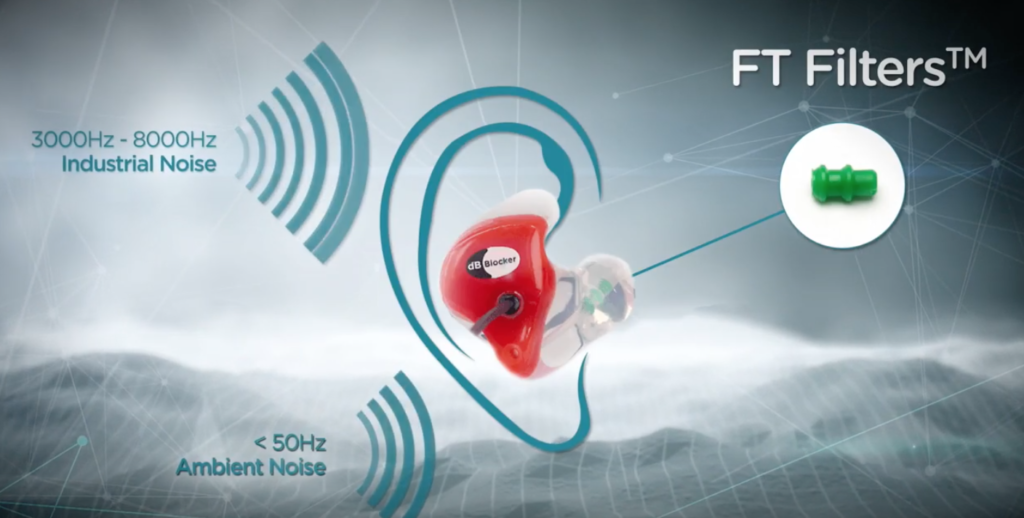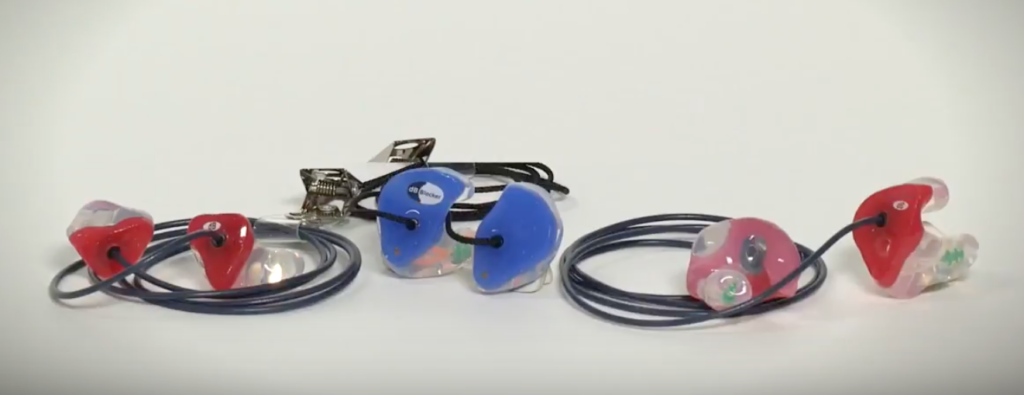Custom versus disposable earplugs
The goal of any earplug is obvious: reduce the volume of sound. And even though it’s true that any earplug can achieve this, it turns out that it’s not that simple, for two reasons:
- All sound is not created equal—The sounds of speech are much different than the sounds of background noise. You want to suppress more of the background noise than of speech or music.
- Sound is dynamic—specific frequencies necessitate different handling, and volume shouldn’t be decreased by too much or by too little.
So, for an earplug to be effective, it has to 1) limit the volume of sound, but not by too much or too little, and 2) deal with assorted types of sounds, or frequencies, differently.

What is a disposable earplug?
So-called “foam” and pre-moulded earplugs are designed to be used for one time or in some cases, a few times. Exceptions to this restriction are those very expensive earplugs such as the Hi-Fi or military earplug that can be cleaned for repeated use.
Until the 1970’s the most common earplug was the V51-R made from soft silicone, a single-flange earplug developed for the military that came in five sizes. Because it didn’t work well, it required precise fitting. Eventually, it was discontinued due to repeated pressures from the scientists and practitioners in the hearing health community. Later other earplugs were developed with multiple flanges.
The slow-recovery foam earplug has the widest use in the world. In the United States, it accounts for approximately 75 percent of all disposable earplugs sold. While the V51-R required precise fitting to be effective, the slow-recovery foam earplug requires rolling down into a small cylinder, inserting as deeply into the ear canal as possible, and then, for some users, holding it in place until it has fully expanded and fills the ear canal, a process that can as long as two minutes depending upon the temperature of the earplug; cooler takes longer than warmer to fully expand. As a result, most wears do not get the noise reduction possible with that earplug (Murphy, 2000). Lets also not forget how much waste disposable ear plugs can cost us in the long run.

What are the advantages and disadvantages of custom-moulded earplugs
Quality of impression
When it comes to custom molds a trained and experience impression taker and the technicians at the laboratory are what makes the custom-moulded earplugs with a guarantee that the ear canal, concha, and helix portions of the ear were accurately obtained. The laboratory can also determine the impression material didn’t distort that ear and ask for a new impression as well. It is in the laboratory’s best interest to ensure that the custom-moulded earplugs that are shipped will fit its user perfectly, provides the de

sired amount of noise reduction, and is comfortable to wear. Uncomfortable earplugs, custom-moulded or not, will either not be used or “field modified” by the wearer to achieve comfort, defeating the entire hearing loss prevention programme in the process.
Quality of Earplug
The custom-moulded earplug’s silicone material will last between three and five years, or longer, depending upon care and handling. Custom-moulded earplugs are that are regularly cleaned last longer than those that aren’t. Rinsing earplugs under warm water is often sufficient for cleaning. If desired, a mild soap solution may be used. Products that have detergents or solvents as bases should not be used to clean custom-moulded earplugs since they may damage the earplug over repeated use.

All ear sizes can be fitted
Whether too large or too small for disposable earplugs, custom –moulded earplugs can be made to fit any healthy ear; any ear free from drainage. Even ears that have unusual shapes due to birth trauma, disease, or surgery can be fitted successfully with custom-moulded earplugs if there is any ear canal present at all, whereas disposable earplugs are designed for normally shaped pinnae and ear canals.
Impressions kept for five years
If the custom-moulded earplug is lost or damaged, it can be replaced without the need to acquire a new impression. All that is required is for the company making the earplug to maintain the impression or mould on file. Then the wearer can contact the maker for a replacement. No new impression is required. After more than five years, a new impression should be taken in any case. The pinna is one body part that continues to change with ageing as it is comprised of 100% cartilage (Ferrario VF, 1999). Thus, the earplug that worked at age 25 may not be as effective in noise reduction at age 31 years. Just to make the issue less comfortable, the soft tissue of the nose also grows with ageing.
Appropriateness of earplug to noise-exposure environment
Custom-moulded earplugs can be made with filters so that the amount and type of attenuation (noise reduction) delivered is no more or less than needed. While a solid custom-moulded earplug may be able to provide about 25 to 30 dB of noise reduction, filters can be inserted into a bore drilled through the earplug that will allow its noise reduction to be lowered to a desired level. A person working in less than 90 dBA of noise may need only 15 dB or so of noise reduction, and filters are available to reliably provide this. Of course, custom-moulded earplugs with filters need more attention to care than solid custom-moulded earplugs so that the filters don’t become blocked with soil or saturated with liquids. Cleansing of these is best done with damp cloth rather than by rinsing or submersion.

So now that you know more about Custom Moulded Earplugs you’ll discover there are even more features that make them better than foam earplugs and have the edge in three critical categories: sound quality, comfort, and cost.
1. Sound Quality
Foam earplugs block out all sound and all frequencies, generating what is known as the occlusion effect for the user, which is the feeling of a “hollow” or “booming” echo-like sound in their own voice. Foam earplugs reduce all-around sound quality and produce a confined sensation.
Custom earplugs, conversely, have special filters for a precise, even level of noise reduction (attenuation). The earplugs can be programmed to reduce volume only by the necessary amount and can filter certain kinds of sound more than others, preserving the quality of speech and music.
2. Comfort
Foam earplugs, to be effective, have to form a deep seal within the ear canal, causing a constant feeling of pressure, and this “plugged up” feeling is nearly universal.
As mentioned earlier, Custom earplugs are molded to the contours of each patient’s ears by a hearing professional, producing a secure, natural fit without the feeling of constant pressure. Custom earplugs are also developed with soft, medical-grade material that doesn’t shrink or change form.
Additionally, foam earplugs are unable to adjust well to variations in ear size and shape. Given that custom earplugs are specially shaped for each patient, variations in ear size and shape pose no problem at all.

3. Cost
Let’s do some quick calculations, beginning with foam earplugs.
Assume that you work in a profession that requires the daily use of earplugs. Assuming an average cost of $0.19 per pair, with use on 5 days a week over 4 years, the total cost would be:
$0.19 X 5 days X 52 weeks X 4 years = $197.60 total cost.
(Also keep in mind the environmental cost: over four years you’d be throwing away 1,040 pairs of earplugs!)
Let’s compare that $197 to the cost of a pair of custom earplugs.
A top quality pair of custom earplugs can last four years or longer, but let’s just assume four. The majority of custom earplugs cost under $100, so your total cost after four years is less than half the cost of the disposable earplugs—and you get better sound quality and comfort in return.
Not to mention that by wearing the same custom earplugs for four years, you’ll eliminate the waste associated with discarding over 1,000 pairs of disposable earplugs.
Custom molded earplugs and disposable earplugs will both reduce volume and protect your hearing, but that’s where the commonalities end. Custom earplugs have far better sound quality, are more comfortable, and cost you and the environment, in the long term, much less.
Want to learn more about WHY CHOOSE CUSTOM-MOULDED OVER DISPOSABLE EARPLUGS?
CLICK HERE TO READ OUR WHITEPAPER


